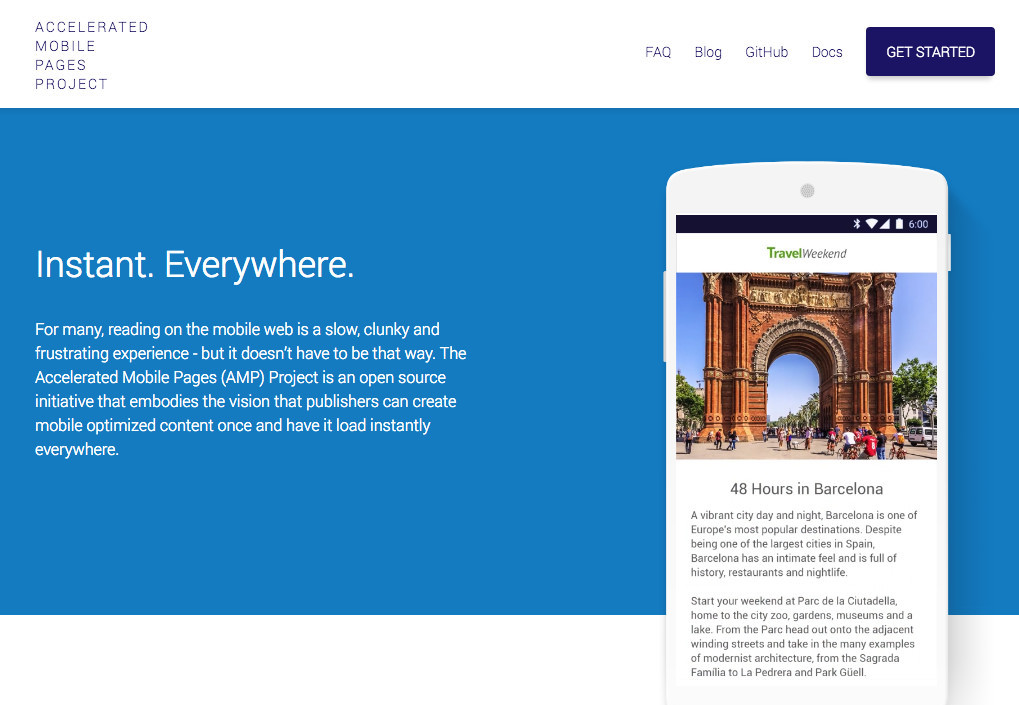AMP – Google Mobile Accelerated Pages

AMP, or Accelerated Mobile Pages is an open-source initiative led by Google, developed to make web content and advertisements perform better, especially on mobile devices. AMP was announced in October of 2015, essentially to be a competitor to Facebook’s instant articles format. Instant articles are pieces of content that has been formatted to natively work inside of Facebook, and AMP is similar. AMP versions of websites often have noticable changes, like simple text based design, far fewer advertisements, or features like comment sections entirely removed.
The Benefits of AMP
One of the benefits of AMP, is that it will improve your website’s placement in mobile search rankings. The reason is that in order for your page to potentially be part of Google’s “new stories carousel” on mobile, the webpage must conform to the AMP standards. For example, if you do a search for Bitcoin on Google (Which at the time of writing is a very popular topic), you will get a top stories carousel. It contains two links at the top, one of which is AMP, and the other of which is the well-respected New York Times. Below it, if you scroll sideways through the panes of articles, every single one of those are AMP pages. Now it is true that having AMP pages only helps you on mobile device search queries. But according to Google’s statistics, more than 50% of all searches are now done on mobile devices. The top stories carousel provides massive visibility, and is a first stop for users when they make a mobile search. If you aren’t a part of that top stories carousel, you will likely miss out on search traffic. Additionally, as of July 2018, Google now counts speed as a factor in mobile search rankings. While they have done this in desktop rankings since 2010, making your website even faster in AMP can help you move up the rankings

So how does that all work?
Since the stated point of AMP is to make mobile web pages blazingly fast, naturally there will be a few changes from a standard web page. For the non-techy, there is a plugin for WordPress blogs that makes your posts AMP ready. You can ask your website manager to add this function.
If you understand more technical elements, AMP pages are built on a stripped-down HTML framework. Some tags are just not allowed, and the same goes for CSS, some elements there cannot be used. The most important behind the scenes change is that JavaScript is basically banned. This makes sense, as having lots of JavaScript will almost guarantee that your page loads slowly. So AMP gives you their own JavaScript library built specifically for it, and also deals with all the caching. Behind all these structural changes is the largest change of AMP, that Google will cache and serve your webpage for you. This is designed to load pages in the fastest way possible, yet still giving some control to the website owner. Even on the cached pages, you can still serve your own ads (Through the JavaScript library) and you can also run tracking pixels, as well as a supported analytics platform. The serving your own ads part is big, as even when Google is caching your pages, you will still get 100% of the revenue from those ads.
The Bottom Line
Especially if you run a content heavy site, it definitely makes sense to get onboard with AMP. Even for people who don’t publish a lot of content (at ten Golden Rules we believe everyone should publish minimum one blog a week!), if you have the resources to set up your pages with AMP, it is something to consider. However, there are cases in which you probably shouldn’t spend your time on AMP. If you are a smaller company with just an informational site, or only post infrequently on your blog, you would probably be better suited spending your time just improving your website in general. It remains to be seen if Google does more with AMP in the future, but even now, AMP can certainly be a valuable addition to your website.

